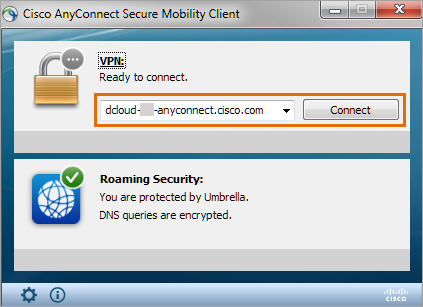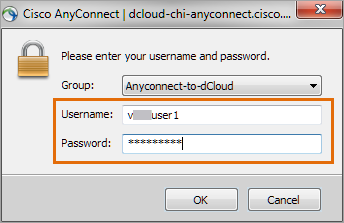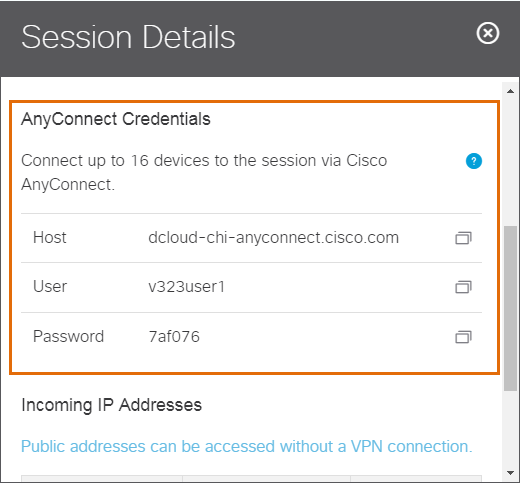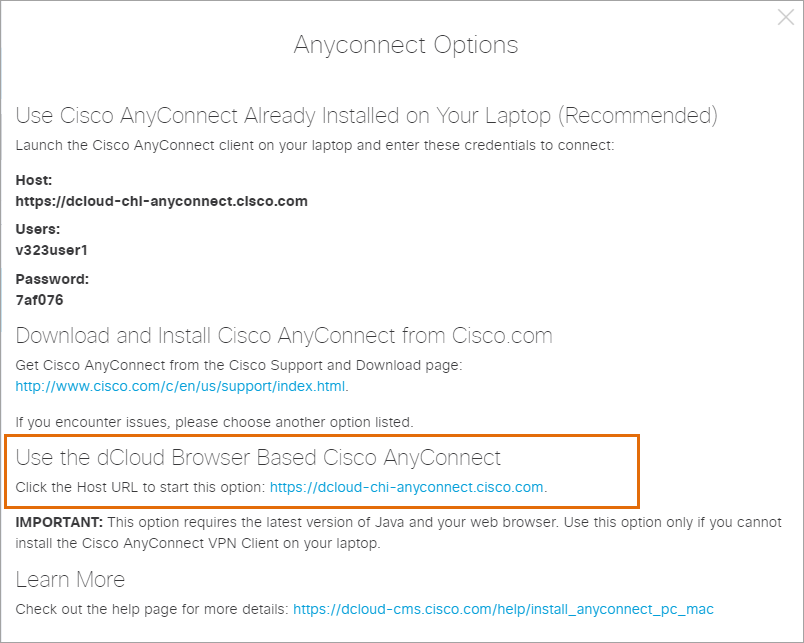dCloud Help
Find the answers you need to get started using dCloud.
Connect Laptop to dCloud Session Using Cisco Secure Client or AnyConnect
April 2024
Access to most active sessions in Cisco dCloud requires a VPN connection between your laptop and the dCloud data center hosting your active session. Use one of the three options below to connect your laptop to an active dCloud session using Cisco AnyConnect VPN Client:
- Use Cisco Secure Client Already Installed on Your Laptop
- Download and Install Cisco Secure Client from Cisco.com
- Use the dCloud Browser-Based Cisco Secure Client
All options are described below in order of recommended use.
Use the Cisco VPN client Already Installed on Your Laptop
- If you are logged in to VPN via Cisco Secure Client, please log off before starting this procedure.
- In dCloud, go to My Hub > Sessions, find the active session, and then click View.
- Click Details.
- In the Session Details window, scroll to the Cisco Secure Client Credentials (or Cisco AnyConnect) section.
- Start Cisco Secure Client (or Cisco AnyConnect) on your laptop.
- Copy the Host URL from the client Credentials, paste it in the URL Connection box in the client (AnyConnect or Secure Client) login window, and then click Connect.
If you get a connection error, remove the “https://” part of the URL and try the connection again.
- Copy a user ID (Users) and the password from the Cisco Secure Client Credentials and then paste each into the Cisco Secure Client login window.
- Click OK.
- Click Accept on the window confirming your connection.
- When connected to your Cisco Secure Client VPN session, the VPN icon displays in the system tray (Windows) or task bar (Mac).
- To view connection details or to disconnect, click the Cisco Secure Client VPN icon, and then choose Disconnect.
Download and Install Cisco's VPN Client from Cisco.com
Download and install the Cisco Secure Client or the Cisco AnyConnect client from Cisco.com:
- Go to the Cisco Support & Downloads page.
- You must be logged in with your Cisco.com credentials.
- You may be prompted to accept or comply with additional terms in order to download the software. Follow the directions in the popup window.
- In the Downloads box, enter secure client or anyconnect if applicable.
- In the search results, choose the version of AnyConnect you want to install.
- Cisco dCloud recommends installing the latest version of Cisco Secure Client or AnyConnect Secure Mobility Client.
- Locate the package you need based on your operating system.
- For Windows users, we recommend choosing Full installation package - Window / Standalone installer (ISO).
- For Mac users, we recommend choosing Full installation package - Mac OS X / Standalone installer (DMG).
- Click Download.
- You may be required to accept or comply with additional terms in order to download the software; follow the directions in the popup windows.
- Review the Cisco End User License Agreement and then click Accept License Agreement.
- Install the AnyConnect software on your laptop.
- In dCloud, go to My Hub > Sessions, find the active session, and then click the View button.
- Click Details.
- In the Session Details window, scroll to the AnyConnect Credentials section.
- The AnyConnect Credentials in your active session are needed to download the software and log in.
- Start Cisco AnyConnect on your laptop.
- Copy the Host URL from the AnyConnect Credentials, paste it in the URL Connection box in the AnyConnect login window, and then click Connect.

If you get a connection error, remove the “https://” part of the URL and try the connection again.
- Copy a user ID (Users) and the Password from the AnyConnect Credentials, paste each into the Cisco AnyConnect login window, and then click OK.

- Click Accept on the window confirming your connection.
- When connected to your AnyConnect VPN session, the AnyConnect VPN icon is displayed in the system tray (Windows) or task bar (Mac).
- To view connection details or to disconnect, click the AnyConnect VPN icon and then choose Disconnect.
Use the dCloud Browser Based Cisco AnyConnect
Due to the Java applet used by this method, you may encounter compatibility issues with your local browser and/or installed version of Java. Use this option only if you cannot install the Cisco AnyConnect VPN Client on your laptop.
To use the dCloud browser based Cisco AnyConnect:
- In dCloud, go to My Hub > Sessions, find the active session, and then click the View button.
- Click Details.
- In the Session Details window, scroll to the AnyConnect Credentials section.
- Scroll down to view the AnyConnect Credentials for your active session, which are needed to download the software and log in.

- Scroll down to view the AnyConnect Credentials for your active session, which are needed to download the software and log in.
- Click the question mark, and then find the section Use the dCloud Browser Based Cisco AnyConnect.
- Click the link next to Click the Host URL to start this option. You are brought to the AnyConnect server address for the dCloud data center hosting your session. For example, the AnyConnect server address for the Americas data center is https://dcloud-rtp-anyconnect.cisco.com.
- Accept any security alerts or certificate warnings.
 The SSL VPN Service window opens in a new browser tab (or new window).
The SSL VPN Service window opens in a new browser tab (or new window).
- Accept any security alerts or certificate warnings.
- Copy a user ID (Users) and the password from the AnyConnect Credentials and then paste each into the SSL VPN Service Login window
- Click Login.
If the automatic installation does not start, close and re-open your browser window.
- Follow the on-screen instructions to connect to AnyConnect.
- Accept any security alerts or certification warnings.
- When you have successfully connected to AnyConnect:
- A window displays, similar to below, advising of a successful connection.
- The AnyConnect VPN icon is displayed in the system tray (Windows) or task bar (Mac).

If the automatic installation fails, install AnyConnect manually by following the on-screen instructions.
- To view connection details or to disconnect, click the AnyConnect VPN icon and then choose Disconnect.
![]() Back to top
Back to top
